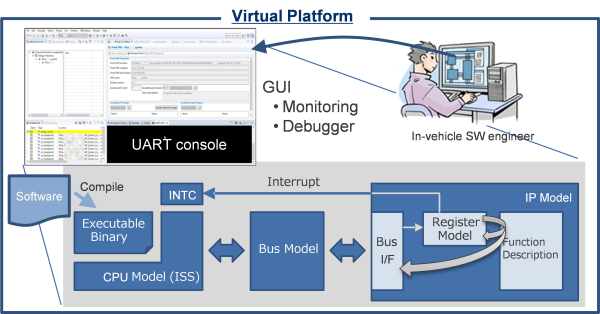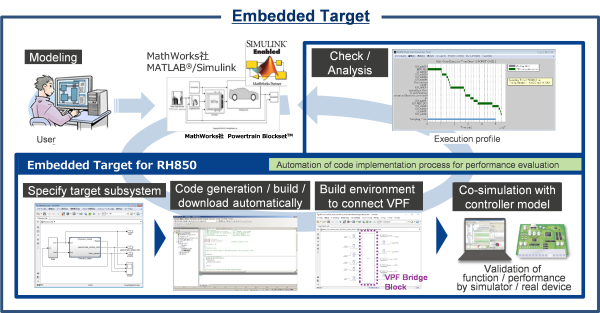Overview
To support shift left of software development and system verification in next-generation vehicles, we develop and provide a Virtual Platform (VPF) that realizes software development in pre-silicon and Embedded Target that enables function / performance validation on target CPU in the algorithm design phase.
Background
In the development of next-generation vehicles, it is necessary to revolutionarily change the development method of in-vehicle systems in order to meet new requirements such as network connection and autonomous driving.
In order to support network connection and autonomous driving, high communication / sensing capabilities, advanced interlocking of cognitive / judgment processing and control operations, enhancement of functional safety and security, etc. are required, and the system, especially software, has become large-scale and complicated. Therefore, algorithm studies in the early stages of vehicle development, software design using semiconductor samples, and system verification have taken a long time. In addition, if a problem occurs in system verification and measures need to be taken in the algorithm design phase, it is necessary to go back much more time to the algorithm design phase, and the risk of rework increases.
In order to solve these issues, we would like to plan, propose, and develop environments / tools that bring new value to vehicles by supporting customers' in-vehicle system development beyond the conventional semiconductor-centered framework.
Examples of our challenges
Based on the above background, we are developing and providing a model-based design environment (*) that reduces the development period of the entire in-vehicle system.
(*) Model-based design: A design method to enable software development and system verification before hardware development and manufacturing by using models.
Developing and providing Virtual Platform (VPF), a model that virtually emulates the functions of an in-vehicle MCU / SoC.
- It makes software development in the pre-silicon phase possible, and the development period can be reduced by parallel development of SoC and software. Furthermore, by developing software at an early stage, shift-left of system verification before hardware design can be achieved and rework can be reduced.
- While faithfully emulating the specifications and behavior of the hardware, high-speed simulation can be made possible by modeling at an appropriate abstraction level. It also becomes a reference for hardware design as a moving specification in the early stages of development when hardware specifications have not been fixed. Therefore, engineers with a wide range of backgrounds, including hardware designers, software designers, and system designers, are participating in the development.
- Developing and providing Embedded Target that automatically generates software and verification environment from algorithm description.
- It enables function / performance validation on the target CPU in the algorithm design phase, and by the validation assuming hardware behavior at an early stage of development, rework can be reduced. Since the verification environment to execute the automatically generated software on VPF can be automatically built, verification linked with VPF can be easily executed and the development period can be reduced.
Engineers with deep expertise and fully experienced in CPU, software, and EDA tools are gathered to develop advanced technologies such as automatic code generation from algorithm description and co-simulation.
Conclusion
Vehicles to make our lives easier are undergoing revolutionary changes. It is the same for the vehicle development environment. We continue to work on providing solutions that support such technological innovations in vehicles.


